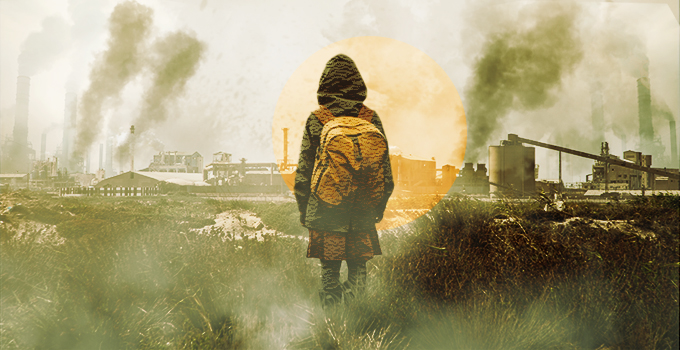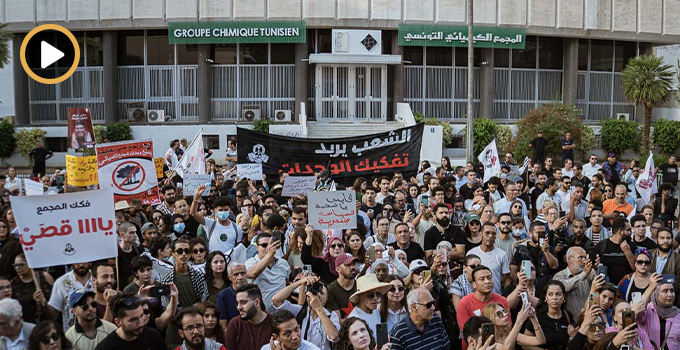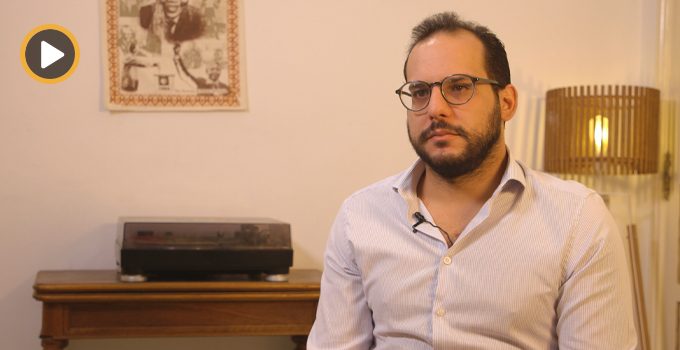The highlands of Tunisia’s north-west hold the national record for rainfall. And yet the region’s scarcity of potable water is a nightmare for inhabitants. In the governorate of Béja, the National Water Distribution Utility (SONEDE) system stops at the borders of M’chargua, Zaga, Toghzaz, Marja Zweraa and Oulèja. The idyllic scenery–abundant flora, lakes and rivers that stretch as far as the eye can see—is in sharp contrast with the emaciated faces of perpetually thirsty villagers. Nawaat visited the region to investigate one of the most absurd injustices of independent Tunisia.
The burden of bringing water
At sixty years old, Jawhara carries strapped to her back 20 liters of water across a distance of three kilometers in the stifling August heat. Patriarchal tradition imposes this daily burden on the women of the region. Young girls, especially those who attend high school and university, carry out this work less and less in order to avoid the sore muscles, sunburn, and humiliation. «They are rebelling», says one water carrier.
Along the way, we meet the local authority, or Omda, Lamine Farhat Mchargui. He spots our camera from the distance and seems to anticipate our questions concerning the multiple promises that have been made to villagers. We follow Mchargui to his home. Next to a rusted gate is the blue SONEDE box which provokes a mix of envy and anger. The Omda’s house is the only one in the village that is connected to the public water supply system. «There is no water because inhabitants aren’t patient. The governor told them that everything will be worked out in the next few days … we even brought an engineer to check out the area two days ago…I can’t say any more than that», mumbles the Omda before disappearing into his home.
According to inhabitants, several requests for access to potable water have been submitted to the delegation of Nefza. «We even organized sit-ins in front of the delegation and the governorate. The delegate has consistently refused to receive us. He finally promised to install a distribution point between hamlets. But nothing has been done», says one of the villagers regretfully.
Everything seems to thirst for water in M’chargua—the houses, the roads, the animals, children who gather under the shade of a tree and slap the ground with empty plastic water bottles. Children here don’t drink enough and don’t shower even in the height of summer heat. «It’s almost noon and they’ve already exhausted the water provisions brought by their mothers this morning», explains Imed, a youth from the village.
«For years, I’ve suffered from terrible back pain. Each time I bring water, I spend two days in bed. We don’t bathe. We don’t clean. We don’t live any more…until they decide to provide us with water», says Mbarka, mother of a large family. Mbarka invites us to take a seat on dust-colored chairs. Her husband presents their children. Youth here leave early: «They flee the misery and the lack of water, transport, and work opportunities».
«January 14 gave us a bit of hope and we believed a real change was taking place», recalls Mohamed, in his thirties and married but still living with his parents. «After several months, they brought back the same Omda [who worked in the time] of Ben Ali. In office for the past twenty years, he has never transmitted our demands to the governors», he adds.
Abutting M’chargua, Ettaref is a little village which once belonged to the delegation of Ouchtata. The village was water scarce for a decade before being connected to the public water distribution supply in 2013. Abbar, a young man from the village, recounts that in spite of intermittent water stoppages «the situation is still better than it was two years ago».
The spring has dried up
On the same path snaking across the mountains and close to a rock quarry, we arrive in Zaga. The village is at the foot of a mountain, surrounded by the deceiving appearance of peace and prosperity that is characteristic of the region. Bringing potable water to the village has become more difficult since the spring dried up two years ago. Women walk almost five kilometers to bring water from Ettaref. In winter when elevated water levels prevent access to the neighboring town, villagers are forced to drive Ouchtata to stock up.
At school, children carry plastic bottles with water for drinking and washing. «When we bring our children to the clinic, the doctor tells us that they are sick as a result of the water quality. But we can’t do anything about it. It’s the only water we have», says Ifa Ben Mustapha, farmer and father of three.
Twenty kilometers from Zaga, we arrive at Toghzaz, delegation of Tabarka, in the governorate of Jendouba. In the shade of a wild laurel tree, Salah contemplates the remains of an old spring. He tells us that the village has four public fountains but that only one is operational since «the others were ruined by the calcareous quality of the water which clogged and rusted the pipes». Without hesitation, he points a finger at «high up officials, but also the former president of the water management group, who haven’t done their jobs».
Forest ranger Abdelhafidh El Habachi explains that the administration’s indifference or incompetence were factors in the failure of a project intended to carry potable water to Toghzaz. El Habachi recalls :
I went to the headquarters of the governorate of Jendouba to complain about the water that floods my house while the village is water-deficient. I wanted to help the authorities manage the distribution of potable water. I ended up abandoning the effort for lack of response.
The water management group of Toghzaz is in the midst of planning a new network which will carry water from the mountain to the village. According to the group, consumers will pay for water in order to cover project expenses and the salary of a caretaker. The group’s president Rachid Toujani confirms that an «operator hired by the group has already brought the pipes. We hope that the work will commence in the coming days».
The government and illegitimate violence
Approximately thirty kilometers from Toghzaz, we arrive in Sidi El Barrak, the second most important dam in Tunisia after Sidi Salem. For the inhabitants of Marjaa Zweraa, Sidi El Barrak is a malediction. In 1995, the government confiscated lands to build the dam. The villagers, most of whom are farmers, have received neither compensation nor access to potable water which was once available.

Mohamed Chargaoui, member of the Association of Rural Development in Toghzaz, tells us that the governorate brought a contractor to take a look at the area and install a water pipeline for the inhabitants. «But he disappeared into thin air after receiving the first installment of his remuneration. We asked for a financial report of the project. Authorities continue to turn a deaf ear». Mohamed’s brother, Abdeljalil Chargaoui, evokes the issue of agriculture:
The region is rich in water. We’ve had it here—free and constant—for a long time. Not only have we been deprived of our lands and potable water, but now we are obligated to pay for irrigation water and are forbidden to dig wells using our own resources.
Reclaiming potable water can lead to prison. In Ouléja, five protesters were dragged before the justice and condemned to eight months in prison following a sit-in. Tension remains palpable in the village especially because renovation work on the spring appears to have been abandoned. A cistern was built, but the connecting tubes have remained sitting at the foot of the hill for months. Like in Togzaz, the contractor left without explanation. One villager tells us,
It’s been like this for three years. Each year, the authorities promise that water distribution will be ready for the summer.
Ali Meliki, delegate of the Regional Commission for Agricultural Development of Béja, explains that the clay composition of the earth in this region prevents the water from reaching the groundwater table which is «the principal factor of the water deficit». Out of the governorate’s 303,000 inhabitants, 55% live in the countryside. The potable water they access is 60% groundwater, 30% from SONEDE, and 10% from springs.
Between 80 and 93% of inhabitants have access to infrastructure and water. On the other hand, close to 15,000 inhabitants are connected to the network but don’t drink … as a result of unpaid bills.
At the same time, Meliki attributes poor management practices to associations which have unpaid debts with STEG and which have neglected maintenance of the distribution networks. «Even their financial reports are not precise. There is a big problem with follow-up between an elected board and its predecessor», he adds.
SONEDE promises that the villages between Béja and Jendouba will all be connected to the potable water system by 2025. For this, the company envisions the construction of a water treatment plant which draws water from the Sidi El Barrak dam, 30 reservoirs, 20 pumping stations, and the installation of 340 kilometers of pipes. We recall that the water in this dam supplies Greater Tunis as well as other cities in the Cap-Bon area. According to SONEDE, the networking of households scattered in the mountains of the north-west is costly. For the inhabitants of Béja and Jendouba who feel that they have been deprived of the region’s natural riches, such reasoning is hardly convincing.





Excellent doc !!! pour une condition misérable …
2025, c’est loin … encore 10 ans, à supposer que les échéances soient respectées, ce qui est rarement le cas …
Une solution autonome (Réservoir + traitement + alimentation solaire photovoltaïque pour le traitement et un éventuel pompage) , même temporaire, ne pourrait-elle pas être envisagée au lieu d’attendre (l’un n’excluant pas l’autre) le bon vouloir des pouvoirs public ?
Je suis curieux de connaitre le nombre d’habitants du village, leurs besoins journaliers (au pire ce qu’ils arrivent à apporter / consommer tous les jours en eau), etc ?
Vous devriez avoir ce type d’infos ? non ? Sans prétention aucune, juste quelques infos pour réfléchir à la question.
D’avance merci,
E.